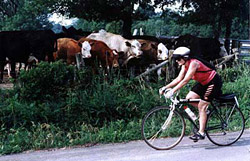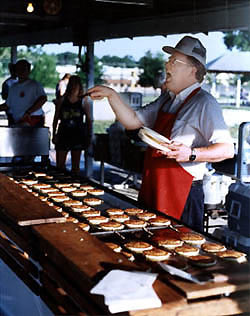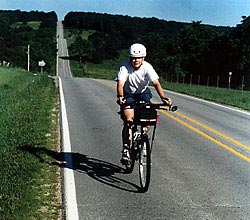
Inge Ucinski of St. Louis rides past some cows
on the last day of CAMP 1996.

The 66 Cafe still lives in Cuba, Mo., as seen
in this photo from 1996.

J im Kuper, The Pancake Man, serves up
a new order in Rolla, Mo., in 1996

Eagle Scout John Lewis climbs a hill
on CAMP 1996.
SUMMARY: CAMP, also known as Cycle Across Missouri Parks, proves once and for all that Missouri is not a flat state.
RIDE WEB SITE:Cycle
Across Missouri Parks no longer exits in this format because
the two organizations that ran the ride, the Gateway Council
of Hostelling International and the Missouri Department of
Natural Resources, decided to go in separate ways. DNR runs a
Katy Trail ride. If you're looking for an easy ride, try the
Katy Trail ride. The Katy Trail is an old railroad converted
into a multipurpose trail. Ride CAM if you seek more of a
challenge. Northern Missouri isn't all that hilly, but be wary
if the route goes through the central or southern part of the
state because there are hills/
• Katy Trail Ride:
http://www.mostateparks.com/katytrail/index.html
Cycle Across
Missouri Parks
CAMP 1993: A return to cycling
After 1987, I went to a job that I didn't particularly like for people I didn't particularly like. I let the job defeat me, and I gave up weeklong cycling trips until 1993. I started working for the Belleville News-Democrat in late 1991, and I spent 1992 rebuilding my love for cycling. I couldn't take a weeklong trip in 1992 because I didn't have any vacation time, but I was bound and determined to do one in 1993.
Several of my friends from the Belleville Area Bicycling and Eating Society decided to do CAMP, Cycle Across Missouri Parks, that year, and I felt confident enough in my fitness to do that ride.
That year, CAMP started in Weston, Mo., along the banks of the Missouri River about 20 miles north of Kansas City. Until that year, I had never realized tobacco was grown in Missouri, but Weston State Park was built on an old tobacco farm. Toward the end of the ride, the going got even slower when my real wheel cracked and went out of true. Fortunately for me, the folks from the Trek support team had a spare wheel and I was able to finish the ride.
On the second day of our trip, I met the man who would provide hours of entertainment for many of my bicycle trips in the next few years. At the lunch stop in Jamestown, Bubba Barron invited me to sit with him. In real life, he's a St. Louis County Police Department sergeant, but on the bicycle, he's Bubba. This was his very first bicycle ride, and he was a bit slower than me. In other days on the ride, I would pass him on the road.
"I know, on your left," Bubba said as I passed him several times on the ride. Bubba's especially good entertaining the children, and he added a lot of fun to CAMP 1993.
I was a bit stronger on the ride from Wallace to Crowder State Park. The third day was from Crowder to Thousand Hills State Park. The name of the park sounds worse than what it really was. The hills in northern Missouri aren't all that difficult.
The ride continued to Mark Twain State Park and Cuivre River State Park.The route to St. Charles had to be rerouted from rural roads in the Mississippi River valley to a busy frontage road along Interstate 70. Rising waters flooded many of the rural roads, and in a matter of weeks, the Flood of 1993 would cover much of St. Charles County. In fact, the parking lot where I parked my car for the week was underwater for several weeks in July and August.
I was so great to realize that I could once again do a weeklong ride.
CAMP 1996: Get Your Kicks on Route 66
Part of this article appeared in the Belleville News-Democrat in July 1996
It takes just 200 miles of cycling for a Boy Scout to earn his cycling merit badge, but 10 members of Troop 52 of Swansea, Ill., needed a bigger challenge than that.
They were among the 338 people who took on the heat, humidity and hills of Missouri during CAMP, which consisted of seven days and 420 miles of cycling. After the first two days of rolling hills, they faced the long, steep downhills and uphills of the Ozarks for five straight days. It didn't take the Scouts long to learn one of the basic laws of Missouri cycling.
"Whatever goes down must come back up," Eagle Scout John Lewis said.
To get an idea how cruel a Missouri hill can be, ponder this one near Meramec State Park. This hill invited cyclists to sit back and enjoy the ride. As downhill speeds approached 40 mph, a railroad crossing suddenly appeared at the bottom of the hill. It was time to hit the brakes or risk a nasty accident at the crossing. By the time cyclists made the crossing, they realized they had an equally huge climb out of the valley. Many just gave up and walked to the top.
This was the debut weeklong trip for my Cannondale R500 racing bike with a triple chainring in front. Thank God I had it for this ride.
The ride started in Lee's Summit, a Kansas City suburb to Knob Noster State Park. From there, the ride rolled into Truman State Park near Warsaw, Ha Ha Tonka State Park near Camdenton, Rolla Lions Park, Onondaga Cave State Park near Leasburg and Meramec State Park near Sullivan before finishing at Mastodon State Park.
In between, the ride featured hamlets such as Tightwad, a town of 50 people near Harry S. Truman Lake, and Montreal, considerably less cosmopolitan than its Canadian namesake.
The route between Ha Ha Tonka and Rolla gave cyclists their first taste of old Route 66, and it was clear why they called it the Mother Road. While much of it has been repaved and given such designations as Routes AB and ZZ, some of it hasn't been surfaced since it was cast aside and replaced by Interstate 44. Cyclists either had to swerve to avoid potholes between the concrete sections of the highway or endure constant shaking from the layers and layers of patching.
For me, it was that constant jarring that wore me out more than the hills. The final day added insult to injury. Most weeklong bicycle trips end with a relatively easy day, but not this version of CAMP. Cyclists were treated to 54 miles of oppressive heat, roads dotted with potholes and paved with coarse gravel. Three hills near Antonio forced many strong riders to dismount.
Nevertheless, the Scouts finished the ride. Seth Wilson, then 12, found the key to success.
"When I started to get tired, I started to tell myself how much farther I had to go," Seth said. "I kept on telling myself, only five more miles to go, only five more miles to go.
"I lied to myself pretty much."